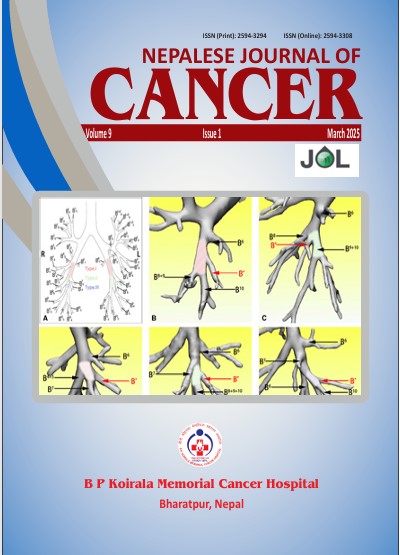Management of ovarian cancer a retrospective study and review of literature
DOI:
https://doi.org/10.3126/njc.v9i1.77094Keywords:
Germ cell malignancies, Borderline ovarian tumors, Epithelial Ovarian Cancer, Interval Debulking Surgery, Neoadjuvant ChemotherapyAbstract
Introduction: Epithelial ovarian cancer is the most lethal gynecological malignancy diagnosed at an advanced stage in the majority of the cases. Management includes primary debulking surgery followed by paclitaxel and carboplatin-based chemotherapy. Neoadjuvant chemotherapy (NACT) followed by interval debulking surgery (IDS) is an alternative option in selected cases of advanced disease. Germ cell malignancies occur in younger age with a good prognosis.
Material and Methodology: A retrospective study of cases visiting our unit for treatment in year 2023-2024 were performed to see the outcomes as we mature to perform more optimal surgery. Altogether 95 cases of carcinoma ovary who had optimally written case notes for retrieval of information for analysis were taken for study and analyzed.
Results: Out of 95 cases, 72 cases (75.78%) were epithelial ovarian malignancies, 18 (18.94%) were germ cell tumors, and 5(5.26%) were borderline tumors. Among epithelial ovarian malignancies high-grade serous carcinoma was the commonest histologic type, mucinous borderline tumors were common among borderline tumors and yolk sac tumors were common among germ cell malignancies. The majority of cases of epithelial ovarian cancer 28 (38.9%) were in the age group of 40-50 years and 75% of them were in advanced stages III and IV. The majority of cases, 33 (45.8%) underwent NACT followed by IDS, 24 (33.3%) underwent primary debulking surgery, and 15 cases (20.8%) received only palliative chemotherapy. The majority of cases of germ cell malignancies were managed by fertility-sparing surgery followed by adjuvant chemotherapy.
Conclusions: Epithelial ovarian cancer is a lethal gynecological malignancy. Primary debulking surgery followed by platinum-based chemotherapy is the standard treatment. Borderline ovarian tumors are common in women of reproductive age 30-40s whereas germ cell malignancies are common in younger girls below 20 years.
Downloads
Downloads
Published
How to Cite
Issue
Section
License
Copyright (c) 2025 Nepalese Journal of Cancer

This work is licensed under a Creative Commons Attribution 4.0 International License.
This license lets others distribute, remix, tweak, and build upon your work, even commercially, as long as NJC and the authors are acknowledged.
Submission of the manuscript means that the authors agree to assign exclusive copyright to NJC. The aim of NJC is to increase the visibility and ease of use of open access scientific and scholarly articles thereby promoting their increased usage and impact.




